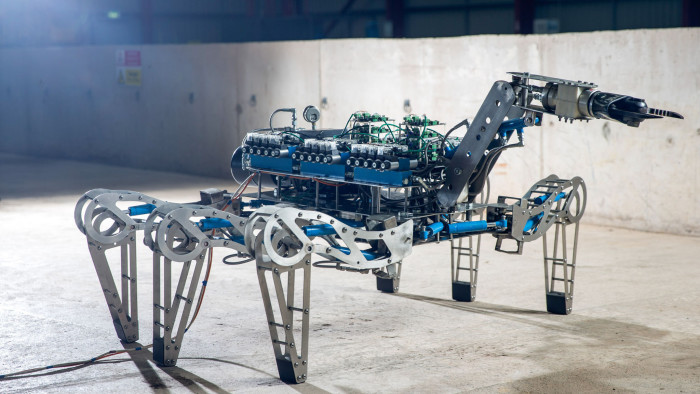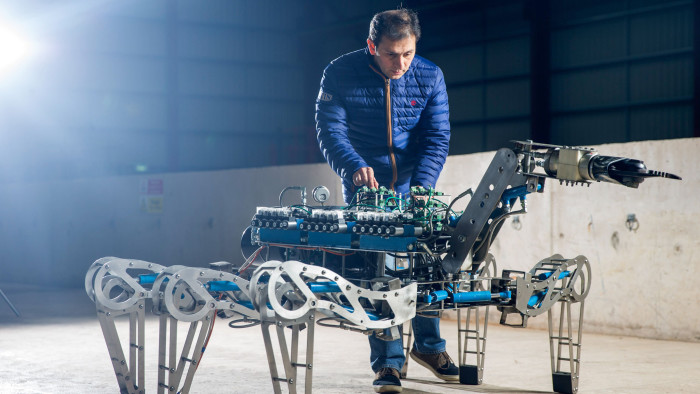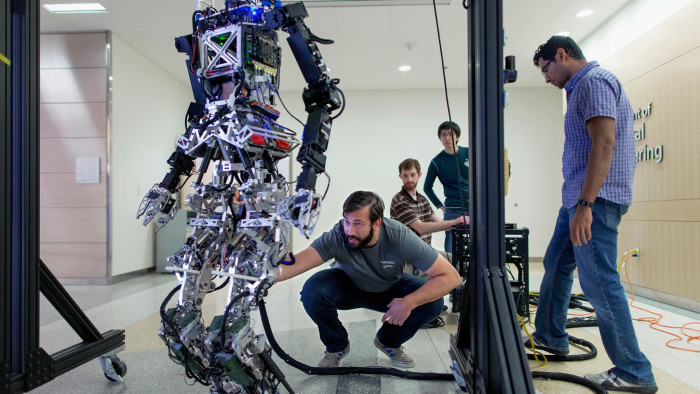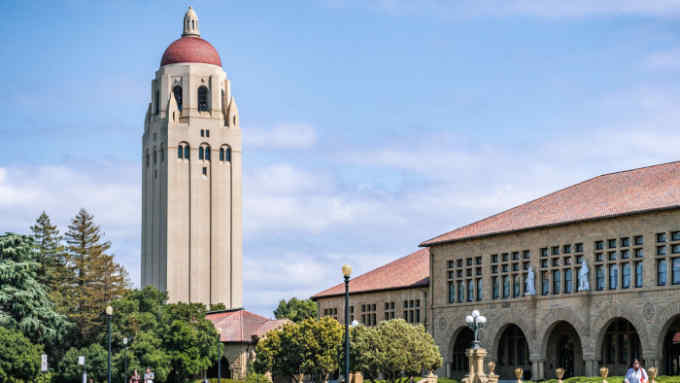Robots rush in where humans fear to tread

Roula Khalaf, Editor of the FT, selects her favourite stories in this weekly newsletter.
In an excruciating scene, the recent HBO series Chernobyl re-enacts Soviet engineers’ attempt to use robots to clear rubble at the site of the eponymous nuclear disaster. Originally intended for lunar exploration, the machines are designed to endure hostile conditions — but still succumb to the intense radiation near the crippled reactor. The authorities have no choice but to get humans to do the work.
Today’s nuclear facilities are far safer but not without risks, from the ageing structures at Sellafield, the UK’s nuclear waste processing site, to Japan’s Fukushima Daiichi power plant, which suffered reactor meltdowns after an earthquake in 2011.
Unlike their Soviet predecessors, though, today’s engineers have access to a growing army of helpful robots that can help with everything from decommissioning to disaster recovery, keeping humans out of harm’s way.
One such is Latro, developed by the University of Manchester and Cumbria-based Forth Engineering, which specialises in robotics for hazardous environments, including offshore energy infrastructure. Armed with camera equipment, laser scanners, cutters and software, Latro is a robotic spider that can retrieve and sort radioactive material from hazardous parts of Sellafield, which has built up a huge inventory of deadly waste since it opened in the 1950s. The university is also developing robotics for the clean-up at Fukushima, where the precise location of some of the nuclear fuel that melted through the containment vessels remains unknown.
“Robotics in this context is about exploration, to access different areas and get a better understanding of what is inside them, what the [radiation] dose rates are, and exactly where the melted fuel is, so you can define the clean-up operation better,” says Professor Barry Lennox, a nuclear decommissioning expert at Manchester’s robotics department.

Public funding is critical to getting such research off the ground but industry linkages matter too. The UK government’s Industry Strategy Challenge Fund, launched in 2016, included £44.5m for new robotics research hubs at four universities, with a remit to develop machines able to work in extreme environments such as offshore installations and outer space. Unlike conventional research council funding, this has an emphasis on “getting technology from universities through to industry deployment”, says Prof Lennox.
The University of Manchester leads the Robotics and AI in Nuclear (Rain) Hub, whose research is guided by an advisory board that includes Sellafield Ltd, Rolls-Royce, AWE and EDF Energy as well as the Office for Nuclear Regulation, a regulator that advises technology transfer to industry. Rain has 38 industry partners, to which it disseminates its research and with which it establishes follow-on projects.
Academics have greater freedom than businesses to take the risks involved in demonstrating that new technology will work in the field. For instance, the Avexis submersible, developed in partnership with Forth, was the first remotely operated vehicle to enter a Sellafield silo whose liquid-filled interior is accessible only via a six-inch hatch.
Once a concept has been proved, the way is clearer for commercial partners. “By deploying first-of-a-kind systems, there is more confidence from industry that they can be put into action,” Prof Lennox says. “That gets end users and the supply chain interested too.”
The University of Manchester is now working with Nuvia, a spinout of now-defunct British Nuclear Fuels, to develop a platform called Carma, which will autonomously survey floors for radioactive contamination. Following a flurry of requests to develop other commercial robots, Manchester researchers have also formed a spinout, called Ice 9. “It can be easier and quicker for us to take our research to industry through our own commercial spinouts, and several universities are now doing this,” Prof Lennox says.
US universities are also pioneering extreme environment robotics. Carnegie Mellon, for instance, has developed critical software for machines such as the Mars rover, Curiosity, and is working on autonomous robots for future missions to asteroids or to Jupiter or Saturn, where the distance makes real-time control from Earth impossible.

As in the UK, researchers in this field rely heavily on public funding, especially from the National Science Foundation, which can catalyse relationships with industry.
Last year, the NSF provided $20m support for “soft robotics”, which develops machines that are more dexterous, flexible and agile than the more familiar variety. This included projects for environments too hostile for humans, such as disaster zones and the deep ocean.
The National Robotics Initiative 2.0, run in partnership with multiple agencies including in agriculture and energy, is currently inviting proposals for projects to give remote access to sites containing chemical, biological or physical hazards.

Government funders can be “a lot more open to innovative ideas” than companies, says Professor Alexander Leonessa, a robotics expert at Virginia Tech, but industry can still benefit from those ideas. Researchers at Virginia Tech, whose earlier projects include autonomous robots for tackling fires on ships, are currently developing exoskeletons to reduce injury in manufacturing environments. They are working in partnership with Sarcos Robotics, a University of Utah spinout that has two decades of exoskeleton experience through collaborations with the Department of Defense and Nasa.
Prof Leonessa says commercial partnerships are based on co-design and feedback rather than financing. “Industry to us is a partner rather than a funder. They work with us to ensure the ideas are marketable and will have use cases later.”
Universities & Innovation
The higher education sector generates lots of intellectual property. We look at how universities, businesses and governments are trying to cash in on it.
How will Brexit hit British research?
The outlook is worrying — but Boris Johnson’s government has been strongly pro-science
Cambridge science parks attract record funding for ‘spinouts’
University-based businesses thrive but ‘Silicon Fen’ faces growing competition
Subscribers can receive alerts when new content is published in this series by following ‘Innovation’ with myFT.
University researchers should focus on innovative prototypes and one-of-a-kind systems, he adds, not mass production. “We want to show that a problem can be solved using robotics and then work with industry so they can take over.”
Such an approach means that academics can focus on pushing the frontiers of knowledge and use real-world engineering problems as teaching devices for their students, who collaborate on product development.
“We are interested in the technology, but also in teaching students how to design and develop these platforms,” says Prof Leonessa. “Industry is not interested in that teaching and learning component. They want a product and they want it quickly, but we are not interested in coming up with a product we already know how to do. We enjoy the novelty and the learning opportunity.”

Comments